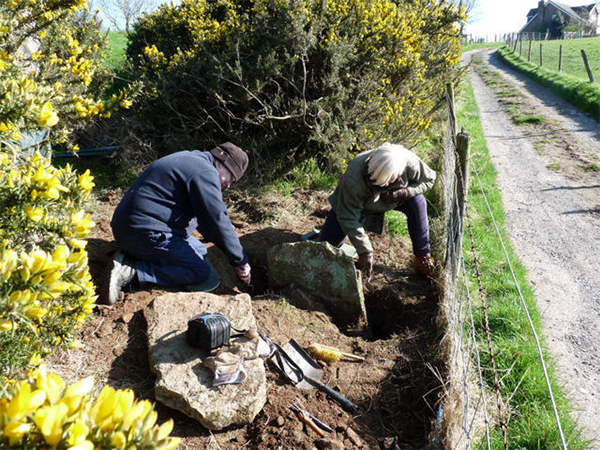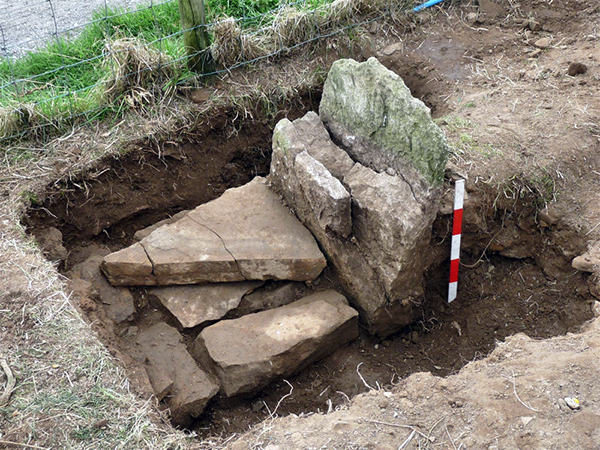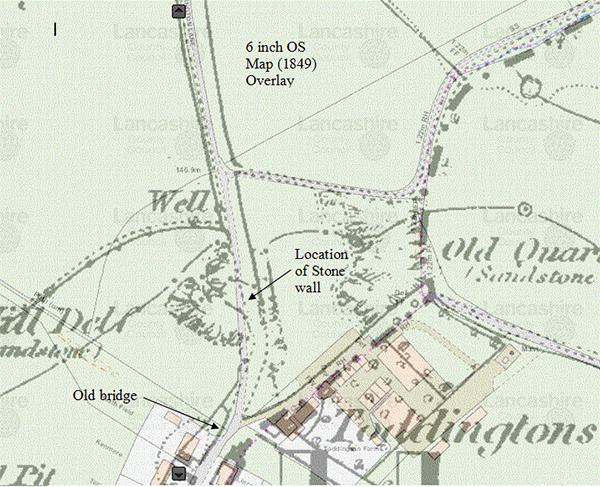
Last month our small team of excavators started work on this enigmatic feature which lies on the roadside part way down Toddington Lane in Haigh. We first became aware of it earlier this year when Mrs Pendlebury invited us to look at it. Our first visit had already established that it probably wasn't ancient despite being on a possible Roman road (see last month's newsletter). However it was significant enough for us to carry out further investigations. In its present condition, only a small section protruded above ground, a much larger piece having been accidently broken-off some time ago by an excavator travelling down the lane. The piece, which lay close by, had no inscription on it on either side. On closer inspection we realised the surfaces had not even been dressed, (although the edge had). Our first task was to clear away the prickly gorse and vegetation, which included a large bush growing out of the cracks it the stone itself. It was obvious that considerable damage had been caused to the stone by the roots (and probably frost) resulting in produced deep vertical cracks. The surrounding ground consisted of course stone rubble which had built up against the stone over the years. As we dug through this, it was obvious that the stone had once been much thicker, sections having broken away from both front and back (this is why the broken-off piece was so rough). It looks like the stone was originally 30 cm thick, but only a 10 cm wide section was left above ground. We could see that the full width of the stone lay buried quite deep in the ground.

On our next visits to the site we were able to establish the true nature of the stone. As we extended our trench to the south, large stone blocks started to appear which seem to butt up against the stone on the south side of it. It seems quite obvious that these are the foundations of a dry stone wall and that the stone itself is the terminal end. As to its age, it is difficult to estimate although we could identify a thick band of soil was butting up to the blocks on the east side. This indicates that the wall must have stood in use in the open for some time. Dating evidence from the small selection of pottery suggests 19th century - further studies of the early OS maps reveal that this area was heavily quarried during that period running right into the 20th century. In fact Mrs Pendlebury reminisces about the quarry at the top of the hill and the colliery line that ran under a bridge on Toddington Lane. This quarry was filled in and the bridge removed in the late 60's. However the 1849 map shows that original quarry actually started further down the hill, precisely where our wall is located.

It seems likely, therefore, that the wall is associated with this activity, particularly since both the soil and the stone blocks seem to be lying above more stone rubble. The 1849 map also shows Toddington Lane running straight through this earlier quarry but on slightly different alignment and much wider than the present lane. This could be cartographers licence but the width would fit with the theory that this road is the proposed Roman road leading from Wigan to Ribchester. On our next visits we will be hoping to explore this possibility with more explorations further down the hill.
CBA NW Archaeology Day
Saturday 6th May at the Grosvenor Museum in Chester. Talks include Iron Age Poulton, the Mesolithic site at the Lunt, Halton & Lancaster Castles and Arkwright's Mill. Booking is on line - let me know if you want details.
Next Meeting
Wednesday 3rd May. - in the Standish Suite at the Brocket Arms (7.30pm as usual). This month Mark Fletcher from Matrix Archaeology will be giving our Society a talk on Manchester's 'Mythical' Castle. It was first mentioned in the late 12th and early 13th centuries but nobody knows exactly where it was or whether it ever really existed. Could it have been just a ring-work around a Saxon burgh. Mark has been carrying out extensive excavations around the Cathedral area where it was supposed to have been located. His talk will cast more light on the mystery. Hope to see you then - BA
|



